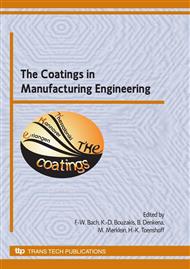p.23
p.31
p.35
p.41
p.49
p.57
p.65
p.73
p.81
Chip Length Effect on the Wear of Coated Cemented Carbide Inserts in Milling
Abstract:
The effect of the developed chip length on the coated tool’s cutting performance was investigated. Milling experiments at various cutting speeds and chip lengths were performed, which resulted to different tool wear developments. To explain these results, a FEM simulation of the cutting process was conducted and the related chip geometries were predicted and compared to the corresponding experimental ones. Based on these results, the Coulomb friction coefficient between chip and tool rake was appropriately adjusted to achieve a sufficient correlation between experimental and computational data. By additional FEM calculations, the mechanical and thermal loads of the cutting edge were estimated and insight was provided concerning the effect of chip length on coated tool stresses and film fatigue fracture. The obtained results revealed that the chip length reduction improves the cutting performance of coated tools and a significant increase of the removed material volume and material removal rate as well can be achieved.
Info:
Periodical:
Pages:
49-56
Citation:
Online since:
May 2010
Keywords:
Price:
Сopyright:
© 2010 Trans Tech Publications Ltd. All Rights Reserved
Share:
Citation:


